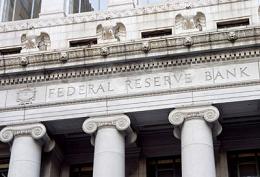
America’s richest investors are betting trillions of dollars that the US economy will stay lousy for years to come.
Who are these wealthy investors?
Bondholders. And their views on the state of the economy are reflected in the yields on long-term US Treasuries. At present, the yields on long-term debt are very low which means that investors think the economy will continue to underperform while inflation remains in check.
This pessimistic outlook is not new for bondholders, in fact, yields have remained stubbornly low since the onset of the financial crisis in 2008, which means that investors were never swept up in the hype about “green shoots” or an “economic recovery”. They knew it was baloney from the get-go and their opinion hasn’t changed. There’s no sign of recovery anywhere except for the fake government payroll numbers that don’t jibe with any of the other data. By any rationale measure, the economy is stuck in a long-term slump that shows no sign of relenting anytime soon. Bondholders seem to grasp that fact and have made a ton of dough betting on crappy growth and perennial stagnation, which are the logical corollaries of the Fed’s goofy monetary policies. (Stephen Roach explains low yields on 30-year USTs here.)
In any event, bond yields are a heckuva lot more helpful in forecasting the future than the cheerleading pundits on the business channel. Yields–which are the amount of return that bondholders receive for lending the government their money–reveal investors expectations of future economic activity and inflation. They are a barometer for measuring the health of the economy. If growth is strong and the future looks rosy, yields will rise as the demand for money increases and the prospects of higher inflation seem more likely. But if investors expect growth to fall-short and disappoint, then yields are going to drop reflecting lower expectations for future activity. The fact that the yields on 30-year USTs are below 3 percent at this phase of the game suggests that policymakers either don’t understand how the economy works or simply refuse to initiate the changes that will spur growth. Either way, it’s a damning indictment of the Central Bank’s role as steward of the system.
At present, (Jan 26) the yield on benchmark 10-year Treasuries is just a whisker below 2 percent at 1.98 percent. That means that investors will get 1.98 dollars annually per every $100 invested, which is nearly nothing. Think of it this way: Let’s say your buddy Ernie wants to borrow $5,000 to open a Gelato stand in Granite Falls. So you’re wondering how much you need to charge him above the price of the loan to be fairly compensated for the risk you’re taking. (since Ernie has had a few bad ideas in the past that blew up in his face.) If you decide to charge him 2 percent per year, then you’re barely making ends meet since inflation is currently running at roughly 1.5 percent. So you need to charge something above 2 percent or you won’t even break-even.
The point is, when you lend your money to the USG for a paltry 1.98 percent, you’re basically getting bupkis on your investment. The only upside to the deal is that you can be reasonably certain that the government will pay you back, unlike Ernie.
The focus on interest rates as the only means for fixing the economy should have run its course by now, but, of course, it hasn’t because the Big Money that runs the country likes things the way they are. Low rates and easy money mean bigger profits for Wall Street regardless of their impact on the real economy. What matters most to bondholders is not growth or inflation, but policy. That’s what keeps the boodle flowing into the coffers. Policy. And as long as they’re confident that the Fed’s “accommodative” policies are going to be coupled with fiscal belt-tightening (which has been adopted by both Dems and Republicans), then they can rest assured that the economy will continue to sputter while bonds “rip the cover off the ball”.
But the Fed’s loosey goosy monetary policies do come at a cost, and that cost is borne by businesses and working people alike. For example, there was an op-ed in last week’s WSJ about the knock-on effects of low rates on capital investment by Michael Spence and Kevin Warsh. The title of the article tells the whole story: “The Fed Has Hurt Business Investment.” Here’s an excerpt:
“Extremely accommodative monetary policy, including the purchase of about $3 trillion in Treasurys and mortgage-backed securities during three rounds of “quantitative easing” (QE), pushed down long-term yields and boosted the value of risk-assets. Higher stock prices were supposed to drive business confidence and higher capital expenditures, which were supposed to result in higher wages and strong consumption. Would it were so.
Business investment in the real economy is weak … In 2014, S&P 500 companies spent considerably more of their operating cash flow on financially engineered buybacks than real capital expenditures for the first time since 2007 … We believe that QE has redirected capital from the real domestic economy to financial assets at home and abroad. In this environment, it is hard to criticize companies that choose “shareholder friendly” share buybacks over investment in a new factory. But public policy shouldn’t bias investments to paper assets over investments in the real economy.” (The Fed Has Hurt Business Investment, Michael Spence And Kevin Warsh, Wall Street Journal)
This is a fairly typical complaint, that the Fed’s policies have lifted asset prices but hurt business investment which requires strong demand for their products. The fact is, businesses can’t grow unless people are employed, wages are rising, and money is exchanging hands. None of that is happening currently, in fact, according to the Atlanta Fed, the Forth Quarter (4Q) GDP is expected to come in below 1 percent. (.06 percent) which means the US economy should probably be wheeled down to the morgue ASAP so the embalming process can begin pronto. For all practical purposes, the economy is kaput.
Of course, President Obama rejects that type of negativity outright. In the State of the Union Speech in January, Obama waved his finger threateningly at the teleprompter saying: “Anyone claiming that America’s economy is in decline is peddling fiction.”
Fiction?? Not according to economist James Hamilton. Here’s what he said this week on the Oil Price website:
“The global economy is slipping into recession. The evidence is showing up in all the usual ways: slowing output growth, slumping purchasing-manager indexes, widening credit spreads, declining corporate earnings, falling inflation expectations, receding capital investment and rising inventories. But this is a most unusual recession– the first one ever caused by falling oil prices.” (Could Low Oil Prices Cause A Global Recession?, Oil Price)
And then there’s this from the Wall Street Journal:
“Every U.S. recession since World War II has been foretold by sharp declines in industrial production, corporate profits and the stock market. Industrial production has declined in 10 of the past 12 months, and is now off nearly 2% from its peak in December 2014. Corporate profits peaked around the summer of 2014 and were off by nearly 5% as of the third quarter of last year. The Dow Jones Industrial Average is down 7.6% so far this year…
unlike past declines in industrial production, today’s decline has been driven primarily by the collapse in the oil industry…. mining output has fallen over 10%, driven by a 62% decline in oil- and gas-well drilling…
“Manufacturing tends to lead the economic cycle and it tends to be an indicator of the swings,” said Thomas Costerg, senior economist at Standard Chartered. “Manufacturing is struggling.” (Recession Warnings May Not Come to Pass, Wall Street Journal)
The truth is that the economy is still very weak and the Fed’s monetary hanky-panky hasn’t produced the credit expansion that was expected. Adding excess reserves at the banks was supposed to boost lending which would lead to stronger growth, but it hasn’t happened mainly because households and consumers aren’t borrowing like they did before the crisis. Instead they’re setting more money aside and trying to pay down their debts. Take a look at the chart on bank loans which illustrates how lending is basically flatlining. (See here.)
No bank loans means no borrowing. No borrowing means no credit expansion. No credit expansion means no new activity, no new spending, no new hiring, no new business investment, no stronger growth. Nomura’s chief economist Richard Koo summed it up succinctly saying, “When no one is borrowing money, monetary policy is largely useless.”
Bingo. It is useless. We know that now. Neither QE nor zero rates promote growth. The ‘Grand Experiment’ has failed. Keynes was right and (Milton) Freidman was wrong. Here’s Keynes:
“For my own part I am now somewhat skeptical of the success of a merely monetary policy directed towards influencing the rate of interest. I expect to see the State, which is in a position to calculate the marginal efficiency of capital-goods on long views and on the basis of the general social advantage, taking an ever greater responsibility for directly organizing investment; since it seems likely that the fluctuations in the market estimation of the marginal efficiency of different types of capital, calculated on the principles I have described above, will be too great to be offset by any practicable changes in the rate of interest.” (John Maynard Keynes, The General Theory of Employment, Interest and Money, marxists.org, 2002)
Keynes is just stating the obvious, that you can’t pull the economy out of a severe slump by tinkering with interest rates or pumping up bank reserves. It doesn’t work. What’s needed is ‘good old fashion’ fiscal stimulus mainlined into the economy through ambitious federal infrastructure programs that stimulate activity, boost employment and keep the economy moving forward until private sector balance sheets are repaired and personal spending returns to normal.
The Fed has wasted the last seven years trying to reinvent the wheel when the solution was always right under its nose. Are we really going to waste another seven implementing the same failed strategy?
Mike Whitney lives in Washington state. He is a contributor to Hopeless: Barack Obama and the Politics of Illusion (AK Press). Hopeless is also available in a Kindle edition. He can be reached at [email protected].
Source Article from http://www.globalresearch.ca/seven-years-of-monetary-quackery-can-the-fed-admit-it-was-wrong-yet/5504342
Related posts:
Views: 0
 RSS Feed
RSS Feed

















 January 28th, 2016
January 28th, 2016  Awake Goy
Awake Goy 
 Posted in
Posted in  Tags:
Tags: 
















